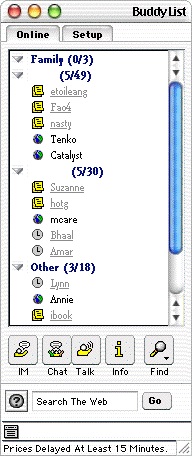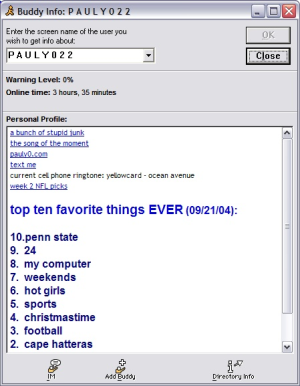
Many people remember specific, weird things about September 11, 2001. For me, it was a headline about stamps tucked into the chaos.
As I started to absorb the horror of the day through TV and online news sources that Tuesday morning, I noticed an odd inflection point highlighted on the Washington Post's list of "Top News" links. While the first three stories were blaring headlines about the terrorist attacks, I remember clearly that the fourth was a news brief about the threat of postal stamp rate increase, the last trivial story published before all other news got pushed aside indefinitely.
I wanted to quickly share this lighthearted observation with my circle of friends, and in 2001 I only had one easy, surefire way to do that online. I brought up AOL Instant Messenger, opened the menu, and chose "Edit Profile." That's where I shared links to the Post's top four stories at the time and warned my friends not to miss the important postal news amid the other stuff going on (I also included a semi-apologetic note that I hoped the lighthearted joke would be a welcome distraction on such a dark day).
Looking back now, I realize that AIM profile was my first ephemeral blog. Going to college in the years before ubiquitous mobile text messaging and social media profiles, AIM's Away Messages and profile pages became a proto-social network for me and a group of peers looking for ways to keep easy tabs on each other. Friday's announcement that AIM would finally shut down after 20 years got me thinking about how we used it to share our status updates years before the online world would be dominated by Twitter, Facebook, and the constant newsfeed.Nice to meet you, what’s your screen name?
My family got our first AOL account in 1996, when I was a freshman in high school. I don't recall using Instant Messaging for much in those days, aside from occasional consulting with colleagues working on my Super Mario Bros. fan site. My high school friends actually gravitated to ICQ and the school's Unix cluster to type messages to each other over dial-up modems.
It's hard to remember now just how freeing it was to be able to communicate instantly without the formality of an actual phone call. Carrying on multiple conversations at once, multitasking between chatting and "surfing the web," and pausing long enough to compose well-thought replies (but not so long that the recipient began to worry) were all brave new frontiers in communication through a much-too-heavy CRT monitor.
Using AIM also meant mastering the etiquette of the Away Message. In the days before we were all tethered to an Internet-enabled device 24/7, we used Away Messages to let others know that we couldn't respond to an Instant Message, while still leaving the computer online in order to receive messages that could be viewed later.
Users with Away Messages up appeared with a little yellow sticky note next to their screen names on AIM's "Buddy List," showing that they were online but not actually around. If you sent a message to someone with an Away Message up, you'd get an instant response notifying you of that fact. You could also set up an Away Message to go up automatically if your computer was idle for too long, in case you stepped away from the computer without thinking.
Getting creative

Away Messages could be customized for the situation and saved for later use. A lot of the early Away Message use in my group of friends was merely functional: "Away at class," or "I'm asleep," or "I'm hanging out down the hall, come join us!" People soon began using their Away Messages as a form of creative self-expression. "Sleeping the sleep of the just (plain exhausted)" was a favorite, as was "Hi ho, hi ho, it's off to class I go." People would also throw up song lyrics, poem quotes, or complete non-sequiturs in lieu of actual information about their whereabouts. I'm sure I had a few Space Ghost: Coast to Coast Away Messages that confused a good deal of my friends.
If you really wanted to get creative with your online persona, though, you had to dive into your AIM profile. This was where you could post text and links that were a little more permanent than an Away Message and available whenever the account was online (which was more-or-less all the time, thanks the brave new world of the campus' broadband network). Seeing a user's profile took a little more work than seeing an Away Message, though; you had to right-click on the username and choose "View Profile" to bring them up one by one (this menu option also let you view the details of an Away Message without having to send an actual message).
While some people kept their profiles unedited for years, many used it as a Twitter-like running diary. One of my friends kept a constantly updated "Thought of the Day" with one-liners picked from overheard quotes and remembered readings. Some used it to post shout-outs to best friends or throw passive-aggressive shade against some unnamed member of the group (but you knew who they were talking about). I often used the space to link to recent photos taken with my first digital camera or game reviews and stories I had published in the student newspaper. Overuse of fancy fonts, colors, and emoticons turned plenty of AIM profiles into crimes against graphic design.
Profile stalking

For much of college, the first thing I would do when I sat down at the computer was go down my AIM friends list and check the profiles and Away Messages to see what was new with everyone. Scanning through profile pages became an easy way to procrastinate when writing a dull paper late at night, presaging the compulsion of scanning Twitter to distract from any sort of boredom (though there was no easy way to quickly figure out which AIM profiles had been updated, meaning you re-read plenty of "old" updates).
Well before Facebook-stalking was a thing, "profile stalking" became slang in my group of friends for any Instant Messenger contact that you didn't talk to but checked up on through the "View Profile" menu. My parents eventually used my frequent profile updates as a sign that I was alive when I hadn't bothered to call home in a few days. At least one of my fellow dorm residents set up a second AIM account just for his friends after his parents started asking him about the risqué content he shared on his profile.
The most striking thing about the profile page, though, was how ephemeral it all was. With limited space to work with, posting something new in your profile usually meant deleting something old (there was even a brief trend of people using "SubProfile" software to slightly expand their profile posting space). AOL Instant Messenger didn't have any built-in way to store old profiles, either. Like Snapchat images, old profiles were not meant to be cherished and archived online but to be thrown to the digital abyss after a while. Today, people who use automated tools to delete old tweets know that there were some benefits to this design.
It seems quaint now, in a world where the US president broadcasts his every thought to millions via social media. After I graduated college, tools like Facebook and Twitter quickly replaced the functions that used to be filled by AIM profile stalking, and programs like Google Chat and text messaging replaced the direct communication portion (especially as more mobile phone providers started offering unlimited SMS plans). Though I still have my AIM account online and connected via Trillian, very few people use it to contact me these days.
Looking back years later, though, it's funny to think how AOL almost certainly didn't intend for Instant Messenger to be used the way me and my friends used it. As the name implies, the program was created as a way for users to send short, "instant" text messages to each other. That was useful, of course, but it was the secondary features—the Away Messages and profiles—that let AIM evolve into much more for a group of early 2000s college kids learning to use an always-on Internet connection for the first time.
As the world says goodbye to AIM over the next few months, I'll remember it for my first taste of how the Internet could enable asynchronous self-expression and personal broadcasting amid a tight-knit social group.
reader comments
97